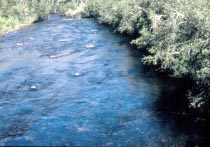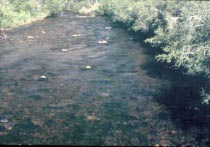Fly Fishing Tips: The Importance of Sunglasses
A good pair of polarizing sunglasses is a necessity and not an accessory! The ability to see through the glare off the water opens a new world to you and increases your fish catching opportunities. Being able to seeing below the surface not only lets you see fish that may be clearly visible but it also lets you clearly see the holding areas and structures that attract fish. An added benefit is making your wading simpler. Light that reflects off the water is generally polarized horizontally. Polarizing lenses work by blocking these rays with vertically orientated polarizes or "grates." The results are amazing. Not all the glare bounces back horizontally. You may need to tilt your head a bit from side to side to get the maximum effect.
Without Polarization |
With Polarization |
(click on either
image for higher resolution comparison) |
|
Norm's recommendations for fly fishing sunglasses
Try this. Spread your arms out wide. Now slowly wiggle your fingers as you bring your arms forward. Your arms won't come very far forward before you will notice the movement. This is your peripheral vision. If your eye is seeing the movement, it is obvious that light is getting to your eyes from the sides. Without side protection your eyes will tire very quickly and your ability to see clearly will be reduced. Consider this when you are selecting your sunglasses and choose ones with side or peripheral glare reduction as well as the glare from directly in front of you. Some people prefer the wrap around type glasses while other prefer,some type of side shield or glacier glasses style. Take your pick but pick one.
Color of Lenses:
In a perfect world we'd have polarizing sunglasses in several different colors for different conditions and locations. But we don't, so we have to make a choice.
 |
The most common color used is a gray lens. Color intensity can range from neutral or a smokey gray to a dark gray. Gray lenses are the best at preserving normal color relationships and decreasing brightness but they do nothing for contrast enhancement. |
 |
Yellow lenses are excellent at gathering light to increase contrast under low to moderate light conditions. These color lenses are also valuable during hazy or foggy condition often encountered during early mornings. This color can be uncomfortable for people with light sensitive eyes. |
 |
Copper /amber lenses are best compromise between the natural color preservation of gray and the contrast enhancement of yellow lenses. Copper/amber lenses are particularly good for rocky streams, and are Helpful with the diffused light conditions of early morning, late evenings and fog |
 |
Vermilion/Rose lenses are the color of choice if you will be fishing in the clear and relatively uniform waters of the salt water flats or in deep slow spring creeks. Under other conditions they tend to decrease fish seeing abilities. But, rose colored glasses will give you a great outlook on life even if the fishing is not as great as you had hoped. |

